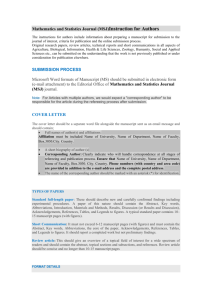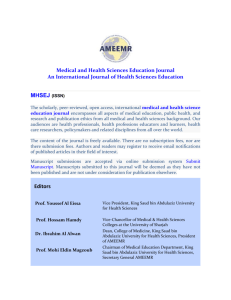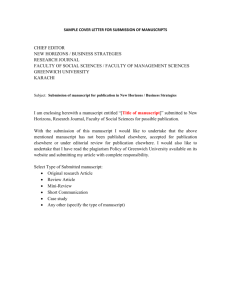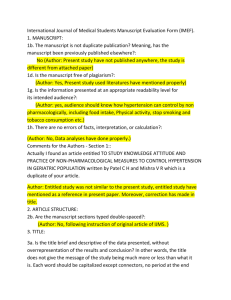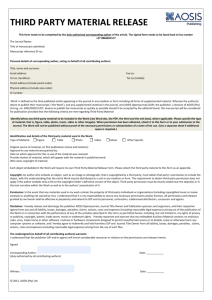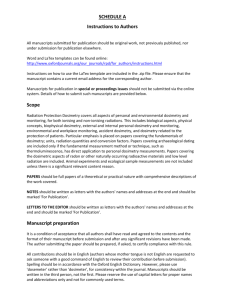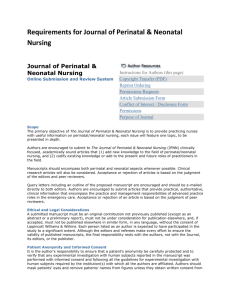Instruction for Authors
advertisement
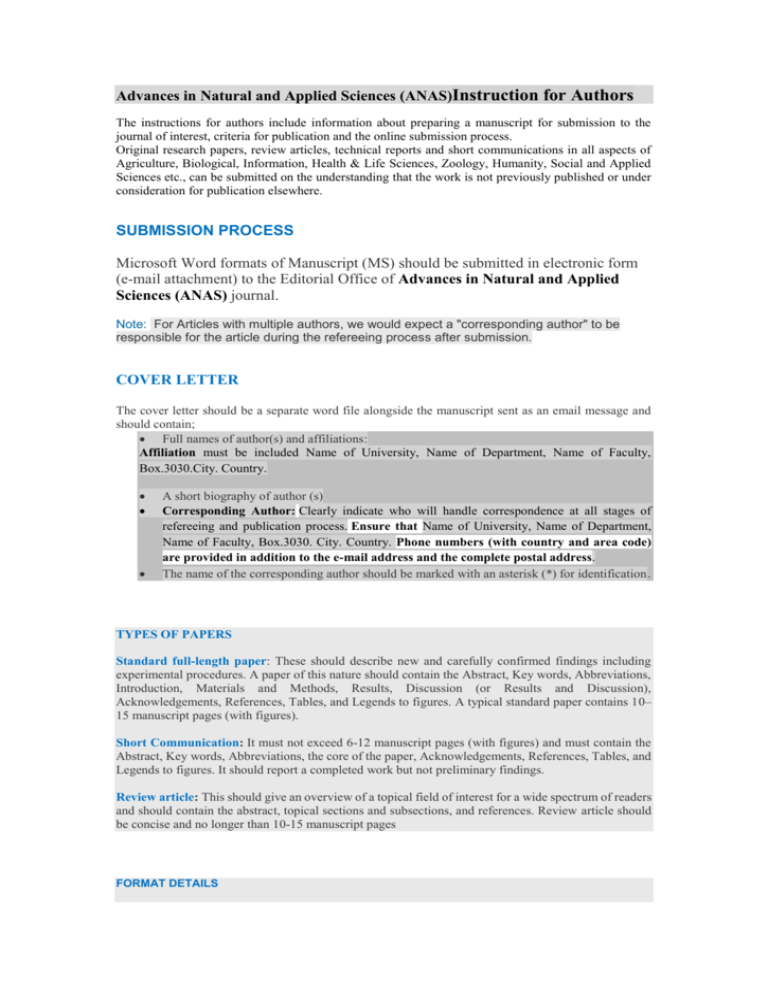
Advances in Natural and Applied Sciences (ANAS)Instruction for Authors The instructions for authors include information about preparing a manuscript for submission to the journal of interest, criteria for publication and the online submission process. Original research papers, review articles, technical reports and short communications in all aspects of Agriculture, Biological, Information, Health & Life Sciences, Zoology, Humanity, Social and Applied Sciences etc., can be submitted on the understanding that the work is not previously published or under consideration for publication elsewhere. SUBMISSION PROCESS Microsoft Word formats of Manuscript (MS) should be submitted in electronic form (e-mail attachment) to the Editorial Office of Advances in Natural and Applied Sciences (ANAS) journal. Note: For Articles with multiple authors, we would expect a "corresponding author" to be responsible for the article during the refereeing process after submission. COVER LETTER The cover letter should be a separate word file alongside the manuscript sent as an email message and should contain; Full names of author(s) and affiliations: Affiliation must be included Name of University, Name of Department, Name of Faculty, Box.3030.City. Country. A short biography of author (s) Corresponding Author: Clearly indicate who will handle correspondence at all stages of refereeing and publication process. Ensure that Name of University, Name of Department, Name of Faculty, Box.3030. City. Country. Phone numbers (with country and area code) are provided in addition to the e-mail address and the complete postal address. The name of the corresponding author should be marked with an asterisk (*) for identification. TYPES OF PAPERS Standard full-length paper: These should describe new and carefully confirmed findings including experimental procedures. A paper of this nature should contain the Abstract, Key words, Abbreviations, Introduction, Materials and Methods, Results, Discussion (or Results and Discussion), Acknowledgements, References, Tables, and Legends to figures. A typical standard paper contains 10– 15 manuscript pages (with figures). Short Communication: It must not exceed 6-12 manuscript pages (with figures) and must contain the Abstract, Key words, Abbreviations, the core of the paper, Acknowledgements, References, Tables, and Legends to figures. It should report a completed work but not preliminary findings. Review article: This should give an overview of a topical field of interest for a wide spectrum of readers and should contain the abstract, topical sections and subsections, and references. Review article should be concise and no longer than 10-15 manuscript pages FORMAT DETAILS Manuscript Style All manuscript should be clearly written in a concise grammatical correct English manner. The author must full the paper in template journal form and Re-write the abstract like the format for AJBAS Journal. Manuscripts that do not conform to these requirements and manuscript format may be returned to the author for correction. Submission of Manuscript Send your manuscripts with attachment to abdel.al-tawaha@mail.mcgill.ca abdeltawaha@yahoo.com along with covering letter. Preparing Manuscripts Text Font: Times new roman Font Size: 10 No Columns Main Headings following main headings should be provided in the manuscript while preparing. Main headings should not be numbered in the manuscript. Introduction Materials and Methods Results Discussion Conclusion Acknowledgement (optional) References Sequence of Preparation Article Title Authors and their full addresses Abstract (300 to 500 words) Key words Introduction Materials and Methods Results Discussion Conclusion Acknowledgement References Abstract Abstract of 300-500 words should be provided summerizing brief Introduction, methods used, results and conclusion of the study. No sub headings should be given in this section. Figures Figures should be of good quality and clearly readable. Graphs and same like figures should be drawn in coreldraw or Microsoft Excel Scientific Pictures should have at least a resolution of 300 DPI (Dots Per Inch) for good printing quality. References References in the text should be in full if they have one or two authors (e.g.: Al-Tawaha, 2004; AlTawaha and Seguin, 2006); in the case of multiple authors they should be cited as Turk et al., 2004. Full References should be provided in the REFERENCES section. References: A. Examples of citation in text The use of an author's name (without initials) followed by a date or year of publication is used for references found in text. For Single author's Perry (2003) early proved that ... This is in agreement with the results obtained by several authors (Brown, 1999; Kramer, 2004; Smith, 2008). For two author's Zhang and Cheng (2001) reported that... This was later found to be incorrect (Kumar and Ahmed, 2000). For three or more authors When there are more than two authors, only the first author‘s name should be mentioned, followed by ’et al‘ as seen below. Prince et al. (1990) stated that... Similar results were reported recently (Smith et al., 2003). In the event that an author cited has had two or more works published during the same year, the reference, both in the text and in the reference list, should be identified by a lower case letter like ’a‘ and ’b‘ after the date to distinguish the works. For Instance (Stephen, 2001a,b) Journal Articles: Ouyang, D., J. Bartholic and J. Selegean, 2005. Assessing Sediment Loading from Agricultural Croplands in the Great Lakes Basin. Journal of American Science, 1(2): 14-21. A Book: Durbin, R., S.R. Eddy, A. Krogh and G. Mitchison, 1999. Biological Sequence Analysis: Probabilistic Models of Proteins and Nucleic Acids. Cambridge University Press. A Chapter in a Book: Leach, J., 1993. Impacts of the zebra mussel (Dreissena polymorpha) on water quality and fish spawning reefs of Western Lake Erie. In Zebra mussels: biology, impacts and control, Eds., Nalepa, T. and D. Schloesser. Ann Arbor, MI: Lewis Publishers, pp: 381-397. A Report: Makarewicz, J.C., T. Lewis and P. Bertram, 1995. Epilimnetic phytoplankton and zooplankton biomass and species composition in Lake Michigan, 1983-1992. U.S. EPA Great Lakes National Program, Chicago, IL. EPA 905-R-95-009. Conference Proceedings: Stock, A., 2004. Signal Transduction in Bacteria. In the Proceedings of the 2004 Markey Scholars Conference, pp: 80-89. A Thesis: Strunk, J.L., 1991. The extraction of mercury from sediment and the geochemical partitioning of mercury in sediments from Lake Superior, M. S. thesis, Michigan State Univ., East Lansing, MI. Abbreviations, Units Etc., Authors should follow internationally agreed rules especially those adopted by the IUPAC-IUB Commission on Biochemical Nomenclature (CBN). The journal will essentially follow the rules defined in the IUPAC Manua1 of symbols and terminology for physico-chemical quantities and units (Butterworths, London), 1970. Copyright and Permissions By submitting a manuscript to the editor or publisher you are deemed to have granted permission to publish the manuscript and distribute it electronically or in any other form to different databases and abstracting services including libraries, universities and anywhere else. Authorship For papers to be published in this Journal, each author should have participated sufficiently in the work to take public responsibility for the content. (This statement is taken from the authorship policy adopted by the International Committee of Medical Journal Editors and published in the Uniform Requirements for Manuscripts Submitted to Biomedical Journals, 1994 and N Engl J Med 336:309315, 1997.) Corrections to published articles. If necessary, corrections of significant errors in published articles will be published in a later issue of the Journal. Within one months after publication, authors are requested to bring any errors to the attention of the managing editor. Proofs will be sent as an Acrobat PDF (Portable Document Format) file. Acrobat Reader will be required in order to read the PDF. This software can be downloaded from the following website: http://www.adobe.com/products/acrobat/readstep2.html This will enable the file to be opened, read on screen and printed out in order for any corrections to be added. Reprints pon final publication, an issue will be made available online, no hard copies of the reprints or journal copy will be supplied To facilitate editorial work, please keep the editorial office informed of any changes in your address, email address and telephone number

